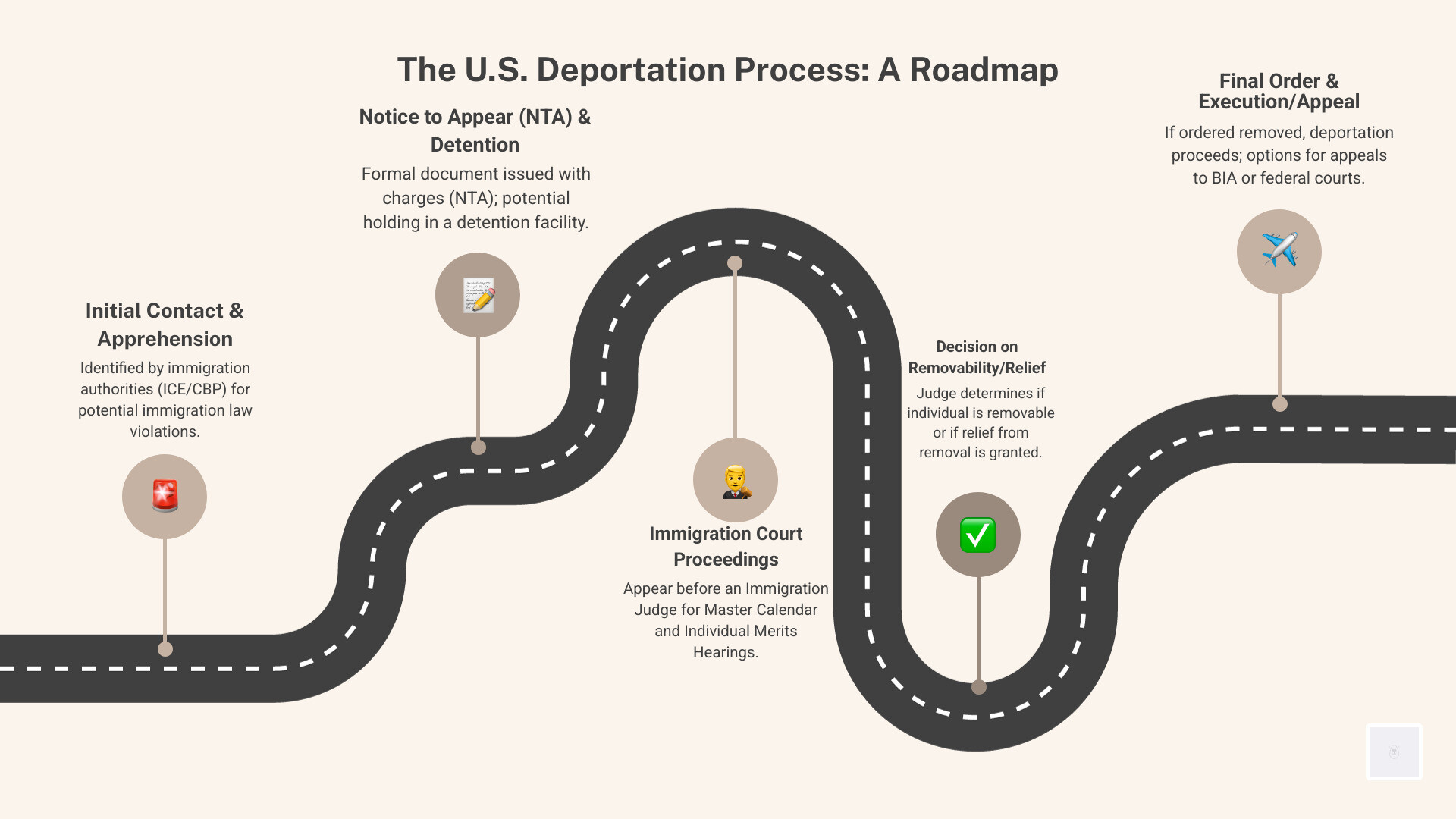The Deportation Lowdown: What You Need to Know
Facing deportation? Learn the U.S. process, your rights, common grounds for removal, and effective defense strategies against deportation.

For many, the word “deportation” brings deep uncertainty. It is a serious legal process. It can change lives forever for individuals and their families.
Navigating the U.S. immigration system can be very complex. Especially when facing potential removal, having clear and reliable information is key. We believe that understanding your rights and the process is the first step toward a strong defense.
In this guide, we will explain what deportation truly means in the U.S. We will detail the steps, from first contact with authorities to the immigration court. We will cover common reasons for removal. And we will share strategies for building a robust defense.
Whether you are seeking basic knowledge or need an Insider ICE DHS deportation defense, this article is here to help. We aim to give you essential information to understand and prepare for what lies ahead.
In the United States, the legal term for “deportation” is “removal.” This process is managed primarily by the Department of Homeland Security (DHS), through its agencies like Immigration and Customs Enforcement (ICE) and Customs and Border Protection (CBP). While the concept of expelling a foreign national from a territory has ancient roots, its modern application in the U.S. is a structured, often lengthy, legal procedure.
The journey towards removal typically begins when an individual is identified by immigration authorities as potentially being in violation of immigration law. This could happen during a routine traffic stop, an encounter at the border, or through information received by ICE. Once identified, the process can unfold in several ways.
One common starting point is the issuance of a Notice to Appear (NTA). This is a formal document that charges a non-citizen with violating immigration law and orders them to appear before an immigration judge. The NTA outlines the specific allegations against the individual and the legal grounds for their potential removal. Receiving an NTA means you are officially placed into removal proceedings.

Upon being issued an NTA, many individuals are subject to immigration detention. This means they are held in an immigration detention facility while their case proceeds through the courts. Detention can be mandatory for certain offenses or immigration violations, while for others, the individual may be eligible for release on bond. Bond hearings are critical opportunities where an immigration judge determines if an individual can be released from detention upon payment of a specified sum, with conditions that they appear for all future court dates.
However, not all removal processes involve an NTA and full court hearings. Expedited Removal is a faster-track process that allows CBP officers to quickly deport certain non-citizens without a hearing before an immigration judge. This typically applies to individuals apprehended at or near the border who cannot establish legal presence in the U.S. or who have made false claims to U.S. citizenship. Rights are significantly limited in this process, making it crucial to understand if you fall under its scope.
Another streamlined process is the Reinstatement of Removal. This applies to individuals who have previously been ordered deported from the U.S. and then re-entered the country illegally. In such cases, the previous removal order can be “reinstated” without a new hearing, leading to swift deportation.
The ultimate arbiter in most removal cases is the Immigration Court system, which falls under the Executive Office for Immigration Review (EOIR) within the Department of Justice. These courts are administrative bodies, separate from the federal judicial system, where immigration judges hear cases and make decisions regarding removability and eligibility for relief from removal. Understanding how these courts operate is vital for anyone facing deportation.

Navigating Immigration Court
Once an individual is placed into removal proceedings and receives a Notice to Appear (NTA), their case enters the Immigration Court system. This process can be daunting, but understanding its structure is key to effective defense.
The first appearance in Immigration Court is typically a Master Calendar Hearing. This is a preliminary hearing where the immigration judge addresses administrative matters. The judge will confirm the individual’s identity, ensure they received and understand the NTA, and ask them to admit or deny the allegations and charges listed in the NTA. During this hearing, the judge will also inquire if the individual intends to seek relief from removal and will set deadlines for filing applications and supporting documents. It’s a procedural step, but a critical one, as it sets the stage for the entire case.
If the individual denies the charges, contests removability, or applies for a form of relief, the case will proceed to an Individual Merits Hearing (also known as a “Contested Hearing”). This is akin to a trial, where both the government (represented by an ICE attorney) and the non-citizen present their arguments and evidence. The Role of the Immigration Judge is to preside over the hearing, consider all evidence, hear testimony, and ultimately make a decision on whether the individual is removable and, if so, whether they are eligible for any form of relief that would allow them to remain in the U.S.
Presenting evidence is a cornerstone of the Individual Merits Hearing. This can include a wide range of documents such as birth certificates, marriage certificates, tax records, employment records, medical records, police reports, and affidavits from witnesses. Testimony from the individual and other witnesses is also crucial. The goal is to demonstrate eligibility for relief or to refute the government’s claims of removability.
Should the immigration judge issue an order of removal, the non-citizen usually has the right to pursue the appeals process. The initial appeal is typically made to the Board of Immigration Appeals (BIA), which is the highest administrative body for interpreting and applying immigration laws. The BIA reviews decisions made by immigration judges. If the BIA upholds the removal order, further appeals may be possible to the federal Circuit Courts of Appeals, and in rare instances, to the U.S. Supreme Court. Each stage of appeal has strict deadlines and procedural requirements, underscoring the complexity of the system.
Why Am I Facing Deportation? Common Grounds for Removal
The U.S. Immigration and Nationality Act (INA) outlines specific grounds for removability, which are the legal reasons why a non-citizen can be deported from the United States. These grounds are broad and can apply to individuals regardless of their current immigration status, including those with lawful permanent residency (green card holders), temporary visa holders, and individuals who are undocumented. Understanding these common grounds is crucial for anyone navigating the immigration system.
One of the most frequent reasons for deportation stems from immigration status violations. This encompasses a range of issues, such as unlawful entry into the U.S. without inspection by immigration officials. Even if an individual entered legally, an overstay of a visa (remaining in the U.S. beyond the authorized period) is a common ground for removal. Violating the terms of a non-immigrant visa, such as working without authorization on a tourist visa, can also lead to deportation proceedings.
Criminal convictions are another significant category that can trigger deportation. Not all crimes lead to removal, but certain offenses have severe immigration consequences. These often include aggravated felonies, a term broadly defined in immigration law to include a wide array of serious crimes, from murder and rape to drug trafficking, theft offenses, and even certain types of fraud, regardless of whether they are considered felonies under state law. Conviction for an aggravated felony almost always leads to mandatory detention and removal, with very limited avenues for relief.
Beyond aggravated felonies, crimes involving moral turpitude (CIMT) can also be grounds for removal. While there’s no precise definition, CIMTs generally involve conduct that is inherently base, vile, or depraved, contrary to the accepted rules of morality and the duties owed between persons or to society in general. Examples often include theft, fraud, assault with intent to cause harm, and certain drug offenses. The number and nature of CIMT convictions can determine removability.
Fraud or misrepresentation in obtaining a visa or other immigration benefit is also a serious ground for deportation. This includes making false statements, presenting fraudulent documents, or concealing material facts during the immigration process. Even a single instance of misrepresentation can lead to permanent bars to future immigration benefits and removal.
Finally, security-related grounds for removal are particularly severe. These apply to individuals deemed a threat to national security, such as those involved in terrorist activities, espionage, or engaging in activities that undermine U.S. foreign policy. Such cases often involve classified evidence and highly complex legal proceedings.
Your Guide to a Strong ICE DHS Deportation Defense
Facing deportation can feel overwhelming, but understanding that you have rights and potential defenses is the first step toward protecting your future. Building a strong defense requires careful planning, thorough preparation, and often, expert legal guidance.
The initial phase involves building a legal strategy. This begins with a comprehensive assessment of your unique situation: your immigration history, any criminal record, family ties in the U.S., and the specific grounds for removal alleged by the government. Based on this assessment, an experienced immigration attorney can identify potential defenses and forms of relief available to you. This strategy might involve challenging the government’s allegations, applying for a form of relief from removal, or a combination of approaches.
Central to any defense is gathering evidence. This includes collecting all relevant documents that support your case, such as birth certificates, marriage certificates, tax returns, employment records, medical records, and police reports. Affidavits from family members, friends, and community leaders can also be crucial in demonstrating your ties to the U.S. and good moral character. The more compelling and well-organized your evidence, the stronger your case will be.
The importance of legal representation cannot be overstated. Immigration law is incredibly complex, with constantly evolving statutes, regulations, and court decisions. An attorney can interpret the law, advise you on your rights, prepare and file necessary applications, represent you in court, and argue your case effectively before an immigration judge. Attempting to steer the system alone significantly reduces your chances of success.
Finally, courtroom preparation is vital. Your attorney will help you understand the procedures, prepare you for testimony, and ensure you are ready for the questions you might face from the judge or the government attorney. Being well-prepared can help alleviate stress and ensure you present your case clearly and confidently.

Seeking Relief: A Foundational ICE DHS Deportation Defense
Even if the government proves you are removable, you might be eligible for various forms of “relief from removal” that could allow you to remain in the United States. These are often the cornerstone of a strong deportation defense.
One of the most well-known forms of relief is Asylum. This is available to individuals who can demonstrate a well-founded fear of persecution in their home country based on one of five protected grounds: race, religion, nationality, membership in a particular social group, or political opinion. To qualify, you must show that the persecution is by the government or by a group the government is unable or unwilling to control. If granted, asylum provides a path to lawful permanent residency.
Closely related to asylum is Withholding of Removal. This form of relief is available to individuals who meet a higher standard of proof than asylum – they must show it is “more likely than not” that they would be persecuted upon return to their home country on a protected ground. Unlike asylum, Withholding of Removal does not lead to a green card; it only prevents deportation to that specific country, and the individual may still be removable to a third country. It is often sought by those who are barred from asylum due to certain criminal convictions or other issues.
Another powerful protection is under the Convention Against Torture (CAT). This prohibits the U.S. from deporting an individual to a country where they would more likely than not be tortured by or with the acquiescence of the government. CAT protection is absolute; there are no bars based on criminal history, making it a crucial avenue for individuals facing severe risks.
Cancellation of Removal is a form of relief available to certain long-term residents. For non-lawful permanent residents, it requires demonstrating continuous physical presence in the U.S. for at least 10 years, good moral character, and proving that your removal would result in exceptional and extremely unusual hardship to a U.S. citizen or lawful permanent resident spouse, parent, or child. For lawful permanent residents, the criteria are different, generally requiring 7 years of continuous residence since admission and not having committed an aggravated felony. The “exceptional and extremely unusual hardship” standard is a high bar, requiring compelling evidence of severe hardship beyond what is typically experienced by a family separated by deportation.
Challenging the Case: An Advanced ICE DHS Deportation Defense
Beyond seeking relief, an advanced deportation defense strategy might involve directly challenging the government’s case or pursuing alternative avenues to resolve the proceedings.
One approach is contesting grounds of removability. This involves arguing that the government has not met its burden of proof in establishing the allegations in the Notice to Appear (NTA). For instance, an attorney might argue that a criminal conviction does not legally qualify as a “crime involving moral turpitude” or an “aggravated felony” under immigration law, or that the individual did not actually commit the alleged immigration violation. This requires a deep understanding of both criminal and immigration law.
In some rare but critical cases, individuals placed in removal proceedings may actually be U.S. citizens. Proving U.S. citizenship is an absolute defense to deportation. This can involve demonstrating birth in the U.S., naturalization, or acquisition/derivation of citizenship through U.S. citizen parents. If citizenship is proven, the immigration court loses jurisdiction over the individual.
For individuals who are otherwise eligible for a green card but are in removal proceedings, Adjustment of Status can be a viable defense. This allows them to apply for lawful permanent residency directly through the immigration court. This typically requires a qualifying family relationship (e.g., marriage to a U.S. citizen) or an employment-based petition, along with demonstrating admissibility to the U.S.
Sometimes, individuals may be inadmissible to the U.S. due to past actions, such as certain criminal convictions or immigration violations. In such cases, Waivers of Inadmissibility can be sought. These waivers forgive certain grounds of inadmissibility, allowing an individual to adjust status or re-enter the U.S. after a prior violation. Eligibility for waivers varies greatly depending on the specific ground of inadmissibility and the individual’s circumstances.
Finally, prosecutorial discretion is an important tool. This refers to the power of the government’s attorney (ICE counsel) to decide how to proceed with a case. They may agree to terminate or administratively close a case, or agree to a specific form of relief, even if the individual is technically removable. Requests for prosecutorial discretion are often based on humanitarian factors, strong equities, or a lack of enforcement priorities. This is not a right, but a request that can be made based on compelling circumstances. For a deeper dive into these strategies, exploring resources on removal defense can provide valuable insights.
Special Circumstances: Families, Victims, and Dreamers
Deportation is not just an individual legal process; it has profound and often devastating impacts on families. When a non-citizen parent, spouse, or child is deported, the ripple effects extend far beyond the individual, affecting U.S. citizen family members who remain in the country. This can lead to severe emotional, psychological, and financial hardship.
A particularly poignant aspect is the plight of U.S. citizen children. These children, born in the U.S. and therefore citizens, often face the difficult choice of remaining in the U.S. without a parent or relocating to a foreign country where they may have no ties, language skills, or support system. This forced relocation of U.S. citizen children due to a parent’s deportation is sometimes referred to as de facto deportation. It highlights the complex humanitarian dimensions of immigration enforcement.
The situation for DACA (Deferred Action for Childhood Arrivals) recipients is also unique. These individuals, often referred to as “Dreamers,” were brought to the U.S. as children and have grown up here, knowing no other home. While DACA provides temporary protection from deportation and work authorization, it does not grant lawful status or a pathway to citizenship. If DACA is rescinded or not renewed, these individuals could be placed into removal proceedings, despite their deep ties to American society.
Beyond family separation, the U.S. immigration system also provides specific protections for victims of crime, recognizing that certain individuals may be particularly vulnerable and deserving of humanitarian consideration.
U Visas are available for victims of certain serious crimes who have suffered substantial physical or mental abuse and who cooperate with law enforcement in the investigation or prosecution of criminal activity. This visa provides temporary legal status and can lead to lawful permanent residency. It is a critical form of relief for non-citizens who might otherwise be afraid to report crimes due to fear of deportation.
Similarly, T Visas are designed to protect victims of severe forms of human trafficking. These visas provide temporary immigration status and can also lead to lawful permanent residency, offering a pathway to safety and recovery for those exploited and trafficked. These protections underscore a humanitarian aspect of U.S. immigration policy, aiming to prevent further victimization and encourage cooperation with justice systems.

Frequently Asked Questions About Deportation
Navigating the complexities of deportation can raise many questions. Here, we address some of the most common inquiries to provide clarity and guidance.
Can a deportation order be stopped or reversed?
Yes, in many cases, an order of removal can be challenged or even reversed. The primary method is through appeals to the Board of Immigration Appeals (BIA). If the BIA upholds the decision, further appeals can be made to the federal Circuit Courts of Appeals. Additionally, in certain circumstances, an individual can file a motion to reopen or a motion to reconsider with the immigration judge, asking them to review their decision based on new facts or a change in law. Success depends heavily on the specific facts of the case, the legal grounds for the challenge, and the timely filing of all required documents.
What are my rights if I am detained by ICE?
If you are detained by ICE, you have important rights. You have the right to remain silent and do not have to answer questions about your immigration status, country of origin, or how you entered the U.S. You also have the right to speak with a lawyer; while the government is not required to provide one for you, you can request to contact an attorney. It is crucial not to sign any documents without fully understanding them and consulting with an attorney, as some documents could waive your rights or lead to your immediate deportation. You generally have the right to a bond hearing before an immigration judge to request release from detention, unless you are subject to mandatory detention under specific immigration laws.
How long does the deportation process typically take?
The timeline for the deportation process varies dramatically and can range from days to many years. Cases in non-detained dockets often take several years to resolve due to significant backlogs in the immigration courts. It is not uncommon for individuals to wait five years or more for their final hearing. Detained cases, however, move much faster, as individuals are held in custody. These cases are prioritized and can often resolve in a matter of months. Expedited removal processes are the quickest, potentially leading to deportation in days or weeks, as they bypass the full immigration court system. The complexity of the individual’s case, the legal defenses raised, the availability of relief, and the court’s caseload are all major factors influencing the overall timeline.
Conclusion: Navigating Your Next Steps
The journey through the U.S. immigration system, especially when facing potential deportation, is undoubtedly one of the most challenging experiences a non-citizen can encounter. As we’ve explored, the process is intricate, governed by complex laws, and fraught with significant consequences for individuals and their families.
However, it is crucial to remember that you have rights, and there are often avenues for defense and relief. Understanding the procedural steps, from the initial Notice to Appear to the various forms of relief available, empowers you to make informed decisions. The value of seeking qualified legal guidance cannot be overstated. An experienced immigration attorney can be your most vital advocate, helping you steer the complexities, build a strong case, and protect your future in the United States.
We hope this guide has provided you with essential insights into the deportation process. While the path ahead may seem daunting, with knowledge and the right support, you can face these challenges with greater confidence and work towards securing your place in this country.











